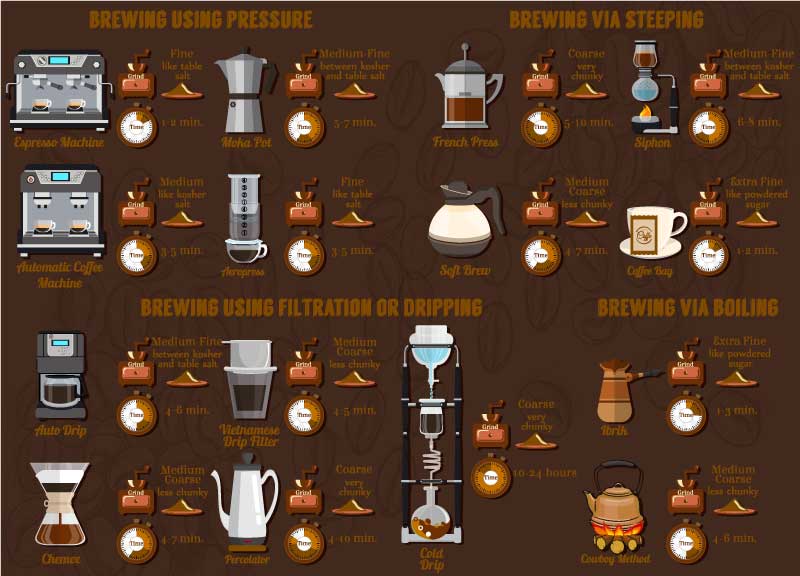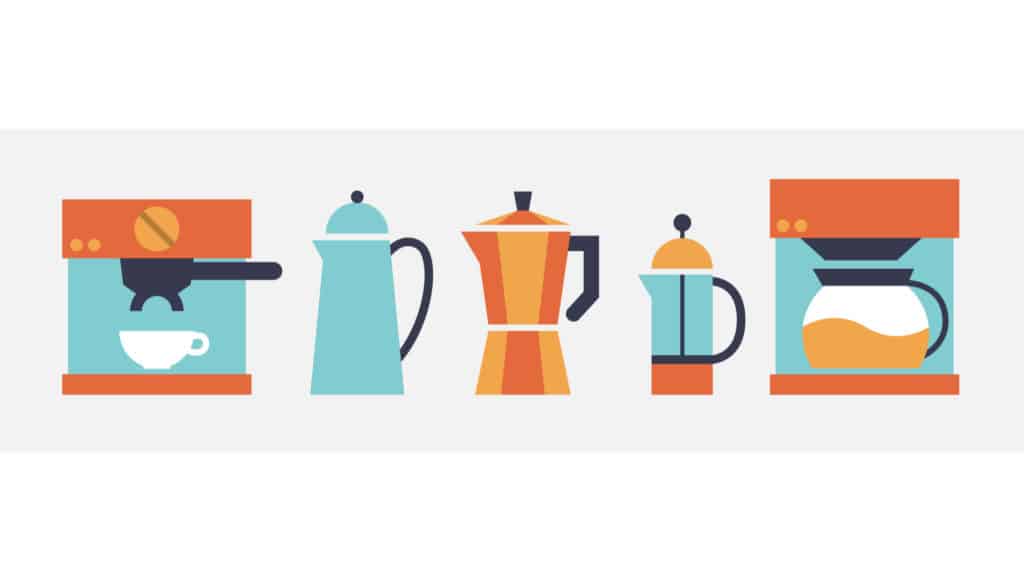There comes a time in every coffee lover’s life when one must make a fundamental decision: to press or not to press? The French press and drip coffee maker are both tried and true options, but is there a discernible winner?
Both brewing methods are worthy unto themselves; however, there are palpable differences. Let’s explore each brewing method in detail and see what works the best for you.
The French Press
The French press is the new kid on the block, at least in the United States. In 2019, Statistica reported that only 4% of American coffee drinkers use the French press brewing method. In Europe, the French press is commonly referred to as a cafetière and is far more popular.
It’s beloved for its superior taste due to the press’s ability to draw out each bean’s oils and flavors more efficiently than a drip coffee maker. It’s also quite portable and easy to use!
History
Contrary to its name, the French press isn’t technically French. According to the New York Times, the French press, commissioned by a Parisian metalsmith in 1852, was patented and perfected by a Milanese enterprise in the late 1920s.
From there, the French press continued to evolve. In 1958, a Swiss gentleman named Faliero Bondanini developed the widely popular Chambord design, commonly used today. The design encompasses a glass vessel, steel lid, and a spherical plunger handle.
Method
The French press is essentially a manual pressing pot. The narrow, cylindrical beaker is paired with a metal or plastic plunger and stainless steel filter to brew a mass of coarsely ground coffee beans. The coffee grounds are dumped into the beaker’s base, are flushed over with boiling water, stirred, and brewed for 2 to 4 minutes.
After the brewing period, the plunger is pushed down to filter the coffee grounds from the liquid coffee base; then, it’s ready to be poured, sipped, and enjoyed. One can typically brew 3 to 8 cups, depending on the size of the French press.
Pros and Cons
When considering whether to buy a French press, it’s essential to consider its features and lack thereof.
On the bright side, the French press is relatively easy to use, with simple mechanics and intuitive features. Additionally, you can customize each cup you brew, whether that’s the temperature, the grounds size, or the water to grounds ratio, if you’re especially picky about your morning wake up call.
However, there are a few downsides: If the coffee is left too long in the beaker, it can begin to taste bitter or stale. For optimal results, pour your coffee immediately after brewing. There’s also a possibility that a few ground bits may remain in your coffee if they’re too fine.
Furthermore, the brewing time can vary depending on how you specialize your serving. This brewing method is also a more hands-on process, with you needing to take time to measure, stir, and time the brew accurately.

Additionally, the clean-up can get a little messy. It’s not uncommon for the filter or base to fill with sludge or coffee grounds. In this case, you may have to perform the arduous task of disassembling the filter from the plunger to remove the gunk entirely.
Your French press’s longevity will depend on the brand and model, with more high-end presses lasting up to 10 years. However, no matter your press, it’s recommended to replace your filter regularly for optimal upkeep.
The Drip Coffee Maker
Compared to the French press, 41% of coffee drinkers in the United States use a drip coffee maker. It’s characterized as a staple of American life — covertly steeping, as the coffee drinker bothers with other things, then pours a quick cup and runs out the door.
History
Initially, coffee lovers brewed the drink using a coffee percolator — a pot that held coffee grounds in a chamber near the lid, with the water below. The water then boiled and traveled up a tube, saturating the coffee grounds, thus brewing coffee.
Melitta Bentz replaced this method by creating the first drip coffee maker and paper filter in 1908. The device was further developed by German inventor Gottlob Widmann who created the first electric drip brewer in 1954.
Method
The drip coffee maker is an automatic brewer, sometimes called a “dripolator.” The machine has a chamber that houses ground coffee, typically held in a filter made of disposable paper. A separate chamber, which contains cold water, funnels the water up a metal tube where it is heated and sprayed onto the coffee grounds. 4 to 5 minutes later, and you’ve got a pot full of light-bodied coffee.
The standard drip coffee maker brews 10-12 cups for those especially inclined to a hefty dose of caffeine. Some drip coffee makers even come with a preset button that allows you to program the machine to start brewing at a certain time, leaving you more time to rest before you have to hustle to work.
Pros and Cons
The virtually hands-off coffee brewing experience may sound appealing, but is it the right fit for you?
When scavenging the market for a drip coffee maker, it’s important to remember that the cup forged by an automatic brewer is less customizable than the cup from a French press. There are typically factory settings that control the temperature and a recommended bean to water ratio.
However, if you’re looking for an effortlessly uncomplicated morning, the drip coffee maker might be the one for you. Just press the button and forget about it.
The drip coffee maker may also be the right fit for coffee drinkers who enjoy a less-intense, lighter flavor. Additionally, its specific brewing method does not unlock the oils sometimes present in coffee brewed by a French press, cultivating a smoother, untainted product.
Furthermore, it takes longer for a drip coffee maker to complete its brew than a French press. Though the amount produced may compensate for this disadvantage.
Conclusion
Ultimately, the debate between the French press and the drip coffee maker comes down to personal preference. Coffee connoisseurs tend to gravitate toward the French press for its refined taste, while the drip coffee maker may already be a partner in crime to those who need more than a few cups of coffee to start the day.

